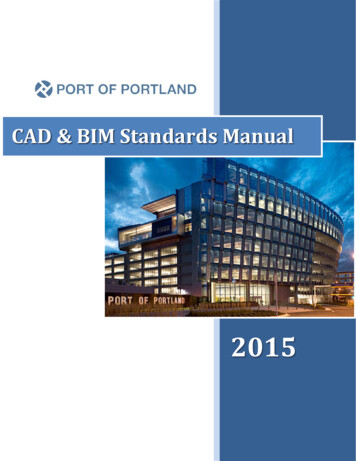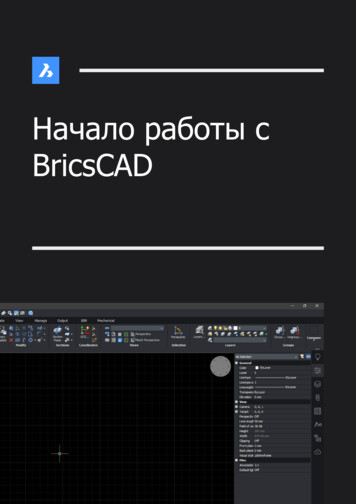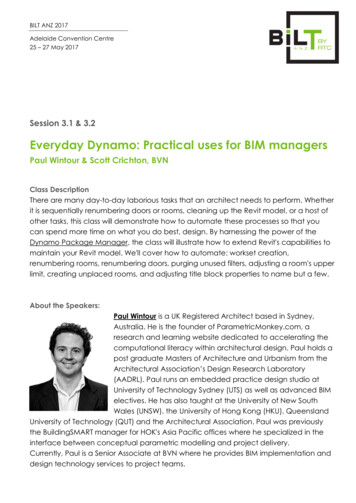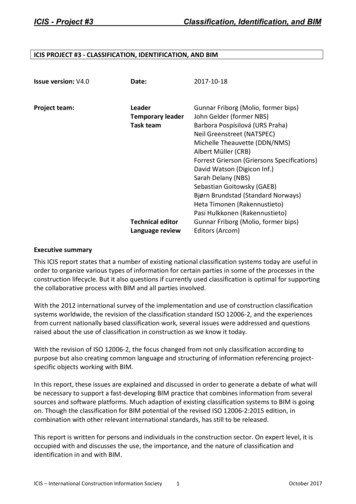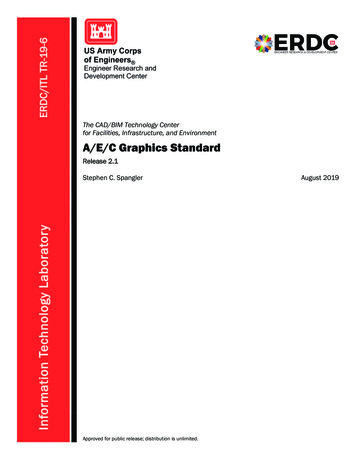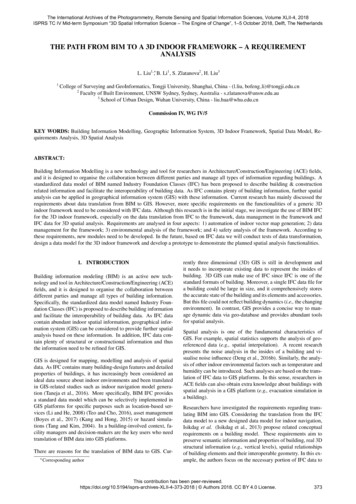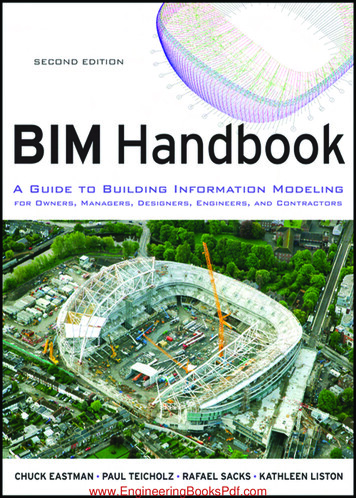
Transcription
www.EngineeringBooksPdf.com
www.EngineeringBooksPdf.com
BIM HandbookA Guide to Building InformationModeling for Owners, Managers,Designers, Engineers, and ContractorsSecond EditionChuck EastmanPaul TeicholzRafael SacksKathleen ListonJohn Wiley & Sons, Inc.www.EngineeringBooksPdf.comffirs.indd i3/8/11 10:53:45 PM
This book is printed on acid-free paper. Copyright 2011 by John Wiley & Sons, Inc. All rights reservedPublished by John Wiley & Sons, Inc., Hoboken, New JerseyPublished simultaneously in CanadaNo part of this publication may be reproduced, stored in a retrieval system, or transmitted in anyform or by any means, electronic, mechanical, photocopying, recording, scanning, or otherwise,except as permitted under Section 107 or 108 of the 1976 United States Copyright Act, withouteither the prior written permission of the Publisher, or authorization through payment of theappropriate per-copy fee to the Copyright Clearance Center, 222 Rosewood Drive, Danvers,MA 01923, (978) 750-8400, fax (978) 646-8600, or on the web at www.copyright.com.Requests to the Publisher for permission should be addressed to the Permissions Department,John Wiley & Sons, Inc., 111 River Street, Hoboken, NJ 07030, (201) 748-6011,fax (201) 748-6008, or online at www.wiley.com/go/permissions.Limit of Liability/Disclaimer of Warranty: While the publisher and the author have used theirbest efforts in preparing this book, they make no representations or warranties with respect tothe accuracy or completeness of the contents of this book and specifically disclaim any impliedwarranties of merchantability or fitness for a particular purpose. No warranty may be created orextended by sales representatives or written sales materials. The advice and strategies containedherein may not be suitable for your situation. You should consult with a professional whereappropriate. Neither the publisher nor the author shall be liable for any loss of profit or anyother commercial damages, including but not limited to special, incidental, consequential, orother damages.For general information about our other products and services, please contact our CustomerCare Department within the United States at (800) 762-2974, outside the United States at (317)572-3993 or fax (317) 572-4002.Wiley also publishes its books in a variety of electronic formats. Some content that appears inprint may not be available in electronic books. For more information about Wiley products,visit our web site at www.wiley.com.Library of Congress Cataloging-in-Publication Data:BIM handbook : a guide to building information modeling for owners, managers, designers,engineers and contractors / Chuck Eastman . . . [et al.]. — 2nd ed.p. cm.Includes bibliographical references and index.ISBN 978-0-470-54137-1 (hardback); 978-0-470-95134-7 (ebk); 978-0-470-95153-8 (ebk);978-1-118-02167-5 (ebk); 978-1-118-02168-2 (ebk); 978-1-118-02169-9 (ebk)1. Building—Computer simulation—Handbooks, manuals, etc. 2. Buildingmanagement—Data processing—Handbooks, manuals, etc. 3. Communication in the buildingtrades—Handbooks, manuals, etc. 4. Architectural practice—Handbooks, manuals, etc.5. Architects and builders—Handbooks, manuals, etc. 6. Construction industry—Informationresources management—Handbooks, manuals, etc. I. Eastman, Charles M.TH437.B53 2011690.0285—dc222010045229Printed in the United States of AmericaSECOND EDITION10 9 8 7 6 5 4 3 2 1www.EngineeringBooksPdf.comffirs.indd ii3/8/11 10:53:46 PM
ContentsCHAPTER 1ForewordviiPrefacexiBIM Handbook TER 2Executive SummaryIntroductionThe Current AEC Business ModelDocumented Inefficiencies of TraditionalApproachesBIM: New Tools and New ProcessesWhat Is Not BIM Technology?What Are the Benefits of BIM? What ProblemsDoes It Address?What Challenges Can Be Expected?Future of Designing and Building withBIM (Chapter 8)Case Studies (Chapter 9)Chapter 1 Discussion Questions1015191926292929BIM Tools and Parametric 7949597Executive SummaryThe Evolution to Object-Based Parametric ModelingParametric Modeling of BuildingsBeyond Parametric ShapesBIM Environments, Platforms, and ToolsOverview of the Major BIM Design PlatformsBIM PlatformsLightweight Modeling ApplicationsConclusionChapter 2 Discussion Questionswww.EngineeringBooksPdf.comftoc.indd iii3/8/11 10:56:24 PM
ivContentsCHAPTER 3Interoperability3.03.13.23.33.43.5CHAPTER 4Executive SummaryIntroductionDifferent Kinds of Exchange FormatsBackground of Product Data ModelsOther Efforts Supporting StandardizationThe Evolution from File-Based Exchange to BuildingModel Repositories3.6 SummaryChapter 3 Discussion Questions99100105110129136BIM for Owners and Facility Managers1514.04.11514.24.34.44.54.64.7CHAPTER 5CHAPTER 699Executive SummaryIntroduction: Why Owners Should CareAbout BIMBIM Application Areas for OwnersBIM Tool Guide for OwnersAn Owner and Facility Manager’sBuilding ModelLeading the BIM Implementationon a ProjectBarriers to Implementing BIM: Risks andCommon MythsGuidelines and Issues for Owners to ConsiderWhen Adopting BIMChapter 4 Discussion Questions148148152155169172175185189191BIM for Architects and Engineers1935.05.15.25.35.45.5Executive SummaryIntroductionScope of Design ServicesBIM Use in Design ProcessesBuilding Object Models and LibrariesConsiderations in Adoption forDesign Practice5.6 New and Changed Staffing withinDesign FirmsChapter 5 Discussion Questions193194197203240BIM for Contractors2636.06.16.26.3263264265268Executive SummaryIntroductionTypes of Construction FirmsInformation Contractors Want from BIM253258260www.EngineeringBooksPdf.comftoc.indd iv3/8/11 10:56:24 PM
Contents6.46.56.66.76.86.96.106.116.126.13CHAPTER 063087.67.77.8CHAPTER 9270BIM for Subcontractors and Fabricators7.47.5CHAPTER 8Processes to Develop a Contractor BuildingInformation ModelReduction of Design Errors UsingClash DetectionQuantity Takeoff and Cost EstimatingConstruction Analysis and PlanningIntegration with Cost and Schedule Controland Other Management FunctionsUse for Offsite FabricationUse of BIM Onsite: Verification, Guidance,and Tracking of Construction ActivitiesSynergies of BIM and Lean ConstructionImplications for Contract and OrganizationalChangesBIM ImplementationChapter 6 Discussion QuestionsExecutive SummaryIntroductionTypes of Subcontractors and FabricatorsThe Benefits of a BIM Process for SubcontractorFabricatorsBIM-Enabled Process ChangeGeneric BIM System Requirementsfor FabricatorsMajor Classes of Fabricators and TheirSpecific NeedsAdopting BIM in a Fabrication OperationConclusionsChapter 7 Discussion Questions310324328333342348348The Future: Building with BIM3518.08.18.28.38.48.5351353353354361Executive SummaryIntroductionThe Development of BIM up to 2010Current TrendsVision 2015Drivers of Change and BIM Impactsup to 2020380BIM Case Studies3919.09.1391397IntroductionAviva Stadiumvwww.EngineeringBooksPdf.comftoc.indd v3/8/11 10:56:24 PM
viContents9.29.39.49.59.69.79.89.99.10Courtyard by MarriottSutter Medical Center, Castro ValleyMaryland General HospitalCrusell Bridge100 11th Avenue, New York CityOne Island East Project, Hong KongHelsinki Music CenterHillwood Commercial ProjectUnited States Coast Guard BIM omftoc.indd vi3/8/11 10:56:25 PM
ForewordIn the seven years since the term “Building Information Modeling” or BIM wasfirst introduced in the AEC industry, it has gone from being a buzzword with ahandful of early adopters to the centerpiece of AEC technology, which encompasses all aspects of the design, construction, and operation of a building.Most of the world’s leading architecture, engineering, and construction firmshave already left behind their earlier, drawing-based, CAD technologies andare using BIM for nearly all of their projects. The majority of other firms alsohave their transitions from CAD to BIM well underway. BIM solutions are nowthe key technology offered by all the established AEC technology vendors thatwere earlier providing CAD solutions. In addition, the number of new technology providers that are developing add-on solutions to extend the capabilities ofthe main BIM applications in various ways is growing at an exponential pace.In short, BIM has not only arrived in the AEC industry but has literally taken itover, which is particularly remarkable in an industry that has historically beennotoriously resistant to change.It is important to keep in mind that BIM is not just a technology change,but also a process change. By enabling a building to be represented by intelligent objects that carry detailed information about themselves and also understand their relationship with other objects in the building model, BIM not onlychanges how building drawings and visualizations are created, but also dramatically alters all of the key processes involved in putting a building together:how the client’s programmatic requirements are captured and used to developspace plans and early-stage concepts; how design alternatives are analyzed foraspects such as energy, structure, spatial configuration, way-finding, cost, constructability, and so on; how multiple team members collaborate on a design,within a single discipline as well as across multiple disciplines; how the building is actually constructed, including the fabrication of different componentsby sub-contractors; and how, after construction, the building facility is operated and maintained. BIM impacts each of these processes by bringing in moreintelligence and greater efficiency. It also goes over and beyond improving existing processes by enabling entirely new capabilities, such as checking a multidisciplinary model for conflicts prior to construction, automatically checking aviiwww.EngineeringBooksPdf.comfbetw.indd vii3/8/11 10:54:48 PM
viiiForeworddesign for satisfaction of building codes, enabling a distributed team to worksimultaneously on a project in real time, and constructing a building directlyfrom a model, thereby passing 2D drawings altogether. It is hardly surprising,then, to find that BIM has also become the catalyst for significant process andcontractual changes in the AEC industry such as the growing move towardsIPD or “Integrated Project Delivery.”Given how vast BIM is, both as a multi-disciplinary design, analysis,construction, and facilities management technology, as well as the harbingerof dramatic process changes, it would seem almost impossible to distill theessence of it in a book. Yet this is precisely what The BIM Handbook has beenable to do. It provides an in-depth understanding of the technology and processes behind building information modeling, the business and organizationalissues associated with its implementation, and the advantages that the effectiveuse of BIM can provide to all members of a project team, including architects,engineers, contractors and sub-contractors, facility owners and operators,as well as building product suppliers who need to model their products sothat they can be incorporated into the building model. The book is targetedtowards both practitioners in the industry as well as students and researchersin academia. For practitioners, it provides not just a deeper understandingof BIM but practical information including the software applications that areavailable, their relative strengths and limitations, costs and needed infrastructure, case studies, and guidance for successful implementation. For studentsand researchers, it provides extensive information on the theoretical aspects ofBIM that will be critical to further study and research in the field.First published in 2008, The BIM Handbook is authored by a team ofleading academics and researchers including Chuck Eastman, Paul Teicholz,Rafael Sacks, and Kathleen Liston. It would be difficult to find a team moresuited to crafting the ultimate book on BIM. Chuck Eastman, in particular,can be regarded as the world’s leading authority on building modeling, afield he has been working in since the 1970s at universities including UCLAand Carnegie-Mellon. I referred to his papers and books extensively duringthe course of my own Ph.D. work in building modeling while I was at UCBerkeley. In 1999, he published the book Building Product Models: ComputerEnvironments Supporting Design and Construction, which was the first andonly book to extensively compile and discuss the concepts, technologies, standards, and projects that had been developed in defining computational datamodels for supporting varied aspects of building design, engineering, and construction. He continues to lead research in the area of building product modelsand IT in building construction in his current role as Professor in the Collegesof Architecture and Computing at Georgia Institute of Technology, Atlanta,www.EngineeringBooksPdf.comfbetw.indd viii3/8/11 10:54:49 PM
Forewordixand Director of Georgia Tech’s Digital Building Laboratory. In addition to hisresearch and teaching work, Chuck is very active in industry associations suchas the AISC, NIBS, FIATECH, and AIA TAP, and is a frequent speaker atindustry conferences.Given his credentials and those of his co-authors including Paul Teicholz,who founded the Center for Integrated Facility Engineering (CIFE) at StanfordUniversity and directed that program for 10 years; Rafael Sacks, AssociateProfessor in Construction Management at the Technion (Israel Institute ofTechnology); and Kathleen Liston, also from Stanford University and an industry practitioner, it is hardly surprising that The BIM Handbook continues to beone of the most comprehensive and authoritative published resources on BIM.This new second edition, coming three years after the publication of the firstedition, keeps up with all of the rapid advances in BIM technology and associated processes, including new BIM tools and updates to the existing tools,the growing availability of model servers for BIM-based collaboration, theincreasing focus on extending BIM technology all the way through to facilitiesmanagement, the growing use of BIM to support sustainable design and leanconstruction, the integration of BIM with technologies such as laser-scanningto capture as-built conditions, and the growing momentum of alternate delivery models such as IPD. The new edition also greatly expands upon the casestudies section of the first edition, highlighting several new projects that havepushed the boundaries of BIM use to achieve exceptional results, both in signature architecture as well as more common building designs.The book is well organized with an executive summary at the beginning ofeach chapter providing a synopsis of its content and a list of relevant discussion questions at the conclusion of each chapter targeted towards students andprofessors. In addition to a bibliography, it includes a very useful Companyand Software Index towards the end of the book that lists all the differentsoftware applications that were discussed in the book and the correspondingpage numbers, not only making it easy to find the sections where a particularsoftware is discussed, but also to get an at-a-glance overview of the extensiverange of BIM and related applications that are currently available.It is not often that practitioners in a field can get the benefits of an extensively researched and meticulously written book, showing evidence of years ofwork rather than something that has been quickly put together in the courseof a few months, as most industry-focused books tend to be. The AEC industryhas been fortunate to have this distinguished team of authors put their effortsinto creating The BIM Handbook. Thanks to them, anyone in the AEC industry looking for a deeper understanding of BIM now knows exactly where tolook for it. It brings together most of the current information about BIM, itswww.EngineeringBooksPdf.comfbetw.indd ix3/8/11 10:54:49 PM
xForewordhistory, as well as its potential future in one convenient place. It is, of course,the must-have text book on BIM for all academic institutions who would liketo teach or research this subject, given the academic and research credentialsof its authors. There were many sections of the book that were illuminatingand insightful even to someone like me, who has been analyzing and writingabout AEC technology for close to ten years now. This helps to gauge howmuch value the book would bring to an AEC practitioner whose prime focuswould be on the actual process of design, construction, or operation of a building rather than a full-time study of the technologies supporting it. True to itstitle, The BIM Handbook indeed serves as a handy reference book on BIM foranyone working in the AEC industry who needs to understand its current andfuture technological state of the art, as BIM is not only what is “in” today butis also the foundation on which smarter and better solutions will be built goingforward.Lachmi Khemlani, Ph.D.Founder and Editor, AECbyteswww.EngineeringBooksPdf.comfbetw.indd x3/8/11 10:54:50 PM
PrefaceThis book is about a new approach to design, construction, and facility management called building information modeling (BIM). It provides an in-depthunderstanding of BIM technologies, the business and organizational issuesassociated with its implementation, and the profound impacts that effectiveuse of BIM can provide to all parties involved in a facility over its lifetime. Thebook explains how designing, constructing, and operating buildings with BIMdiffers from pursuing the same activities in the traditional way using drawings,whether paper or electronic.BIM is beginning to change the way buildings look, the way they function,and the ways in which they are built. Throughout the book, we have intentionally and consistently used the term “BIM” to describe an activity (meaningbuilding information modeling), rather than an object (building informationmodel). This reflects our belief that BIM is not a thing or a type of softwarebut a human activity that ultimately involves broad process changes in design,construction and facility management.Perhaps most important is that BIM creates significant opportunity forsociety at large to achieve more sustainable building construction processesand higher performance facilities with fewer resources and lower risk than canbe achieved using traditional practices.Why a BIM Handbook?Our motivation in writing this book was to provide a thorough and consolidatedreference to help students and practitioners in the construction industry learnabout this exciting new approach, in a format independent of the commercialinterests that guide vendors’ literature on the subject. There are many truths andmyths in the generally accepted perceptions of the state of the art of BIM. Wehope that The BIM Handbook will help reinforce the truths, dispel the myths,and guide our readers to successful implementations. Some well-meaning decision-makers and practitioners in the construction industry at-large have had disappointing experiences after attempting to adopt BIM, because their efforts andexpectations were based on misconceptions and inadequate planning. If this bookcan help readers avoid these frustrations and costs, we will have succeeded.Collectively, the authors have a wealth of experience with BIM, bothwith the technologies it uses and the processes it supports. We believe thatBIM represents a paradigm change that will have far-reaching impacts andxiwww.EngineeringBooksPdf.comfpref.indd xi3/8/11 10:55:19 PM
xiiPrefacebenefits, not only for those in the construction industry but for society at-large, asbetter buildings are built that consume fewer materials and require less laborand capital resources and that operate more efficiently. We make no claim thatthe book is objective in terms of our judgment of the necessity for BIM. At thesame time, of course, we have made every effort to ensure the accuracy andcompleteness of the facts and figures presented.Who Is The BIM Handbook For, and What Is in It?The BIM Handbook is addressed to building developers, owners, managers,and inspectors; to architects, engineers of all disciplines, construction contractors, and fabricators; and to students of architecture, civil engineering, andbuilding construction. It reviews Building Information Modeling and its relatedtechnologies, its potential benefits, its costs and needed infrastructure. It alsodiscusses the present and future influences of BIM on regulatory agencies; legalpractice associated with the building industry; and manufacturers of buildingproducts—it is directed at readers in these areas. A rich set of BIM case studiesare presented and various BIM tools and technologies are described. Currentand future industry and societal impacts are also explored.The book has four sections:I. Chapters 1, 2, and 3 provide an introduction to BIM and the technologies that support it. These chapters describe the current state of theconstruction industry, the potential benefits of BIM, the technologiesunderlying BIM including parametric modeling of buildings and interoperability.II. Chapters 4, 5, 6, and 7 provide discipline-specific perspectives of BIM.They are aimed at owners (Chapter 4), designers of all kinds (Chapter5), general contractors (Chapter 6), and subcontractors and fabricators(Chapter 7).III. Chapter 8 discusses potential impacts and future trends associatedwith the advent of BIM-enabled design, construction, and operation ofbuildings. Current trends are described and extrapolated through theyear 2015, as are forecasts of potential long-term developments and theresearch needed to support them through 2020.IV. Chapter 9 provides ten detailed cases studies of BIM in the design andconstruction industry that demonstrate its use for feasibility studies,conceptual design, detail design, estimating, detailing, coordination, construction planning, logistics, operations and many other commonconstruction activities. The case studies include buildings with signaturearchitectural and structural designs (such as the Aviva Stadium in Dublin, the 100 11th Avenue apartment building facade in New York City,and the environmentally friendly Music Hall in Helsinki) as well as awide range of fairly common buildings (a Marriott Hotel renovation,a hospital, a high-rise office building, and a mixed commercial and retailwww.EngineeringBooksPdf.comfpref.indd xii3/8/11 10:55:19 PM
Prefacexiiidevelopment, and a coast-guard training facility). There is also a studyof a single tower cable-stayed bridge in Finland.What’s New in This Edition?BIM is developing rapidly, and it is difficult to keep up with the advances inboth technology and practice. Integrated Project Delivery (IPD) is a collaborative contracting paradigm that has been developed and adopted within thethree years since we completed the first edition. BIM tools are increasingly usedto support sustainable design, construction, and operation. There has beenincreasing support by BIM for lean design and construction methods whichare highlighted throughout the book. Some innovations we predicted wouldbecome commercial by 2012, such as tracking of building components usingBIM and radio-frequency ID tagging, have already been used in practice.This edition not only addresses these themes and updates the material relatedto the BIM applications; it also introduces sections on new technologies, such aslaser scanning and BIM servers. It also includes six new case studies.How to use The BIM HandbookMany readers will find the Handbook a useful resource whenever they areconfronted with new terms and ideas related to BIM in the course of theirwork or study. A thorough first-reading, while not essential, is of course thebest way to gain a deeper understanding of the significant changes that BIM isbringing to the AEC/FM industry.The first section (Chapters 1–3) is recommended for all readers. It gives abackground to the commercial context and the technologies for BIM. Chapter 1lists many of the potential benefits that can be expected. It first describes thedifficulties inherent in current practice within the U.S. construction industryand its associated poor productivity and higher costs. It then describes various approaches to procuring construction, such as traditional design-bid-build,design-build, and others, describing the pros and cons for each in terms ofrealizing benefits from the use of BIM. It describes newer integrated projectdelivery (IPD) approaches that are particularly useful when supported by BIM.Chapter 2 details the technological foundations of BIM, in particular parametric and object-oriented modeling. The history of these technologies and theircurrent state of the art are described. The chapter then reviews the leadingcommercial application platforms for generating building information models.Chapter 3 deals with the intricacies of interoperability, including how building information can be communicated and shared from profession to profession and from application to application. The relevant standards, such as IFC(Industry Foundation Classes) and the U.S. National BIM Standards are covered in detail. Chapters 2 and 3 can also be used as a reference for the technicalaspects of parametric modeling and interoperability.Readers who desire specific information on how they can adopt andimplement BIM in their companies can find the details they need in thewww.EngineeringBooksPdf.comfpref.indd xiii3/8/11 10:55:20 PM
xivPrefacerelevant chapter for their profession within Chapters 4–7. You may wish toread the chapter closest to your area of interest and then only the executive summaries of each of the other chapters. There is some overlap within these chapters,where issues are relevant to multiple professions (for example, subcontractorswill find relevant information in Chapters 6 and 7). These chapters make frequentreference to the set of detailed case studies provided in Chapter 9.Those who wish to learn about the long-term technological, economic,organizational, societal, and professional implications of BIM and how theymay impact your educational or professional life will find an extensive discussion of these issues in Chapter 8.The case studies in Chapter 9 each tell a story about different professionals’ experiences using BIM on their projects. No one case study representsa “complete” implementation or covers the entire building lifecycle. In mostcases, the building was not complete when the study was written. But takentogether, they paint a picture of the variety of uses and the benefits and problems that these pioneering firms have already experienced. They illustrate whatcould be achieved with existing BIM technology at the start of the 21st century.There are many lessons learned that can provide assistance to our readers andguide practices in future efforts.Finally, students and professors are encouraged to make use of the studyquestions and exercises provided at the conclusion of each chapter.AcknowledgmentsNaturally, we are indebted first and foremost to our families, who have all bornethe brunt of the extensive time we have invested in this book. Our thanks andappreciation for the highly professional work of Lauren Poplawski, EditorialProgram Coordinator, and to Kathryn Bourgoine, Acquisitions Editor, both atJohn Wiley and Sons.Our research for the book was greatly facilitated by numerous builders,designers, and owners, representatives of software companies and government agencies; we thank them all sincerely. Five of the case studies were originally prepared by graduate students in the College of Architecture at GeorgiaTech, and others were initially drafted by students at the School of the BuiltEnvironment at the University of Salford, and at the Tallinn University ofApplied Sciences; we thank them, and their efforts are acknowledged personally at the end of each relevant case study. The case studies were made possiblethrough the very generous contributions of the project participants who corresponded with us extensively and shared their understanding and insights.Finally, we are grateful to Lachmi Khemlani for her enlightening forewordto this second edition and for her significant contributions to BIM, reflected inher publication of AECbytes. Finally, we are grateful to Jerry Laiserin for hisenlightening foreword in the first edition and for helping to initiate the originalidea for The BIM Handbook.www.EngineeringBooksPdf.comfpref.indd xiv3/8/11 10:55:20 PM
CHAPTER1BIM Handbook Introduction1.0 EXECUTIVE SUMMARYBuilding Information Modeling (BIM) is one of the most promising developments in the architecture, engineering, and construction (AEC) industries.With BIM technology, one or more accurate virtual models of a building areconstructed digitally. They support design through its phases, allowing betteranalysis and control than manual processes. When completed, these computergenerated models contain precise geometry and data needed to support theconstruction, fabrication, and procurement activities through which the buildingis realized.BIM also accommodates many of the functions needed to model the lifecycleof a building, providing the basis for new design and construction capabilitiesand changes in the roles and relationships among a project team. When adoptedwell, BIM facilitates a more integrated design and construction process thatresults in better quality buildings at lower cost and reduced project duration.This chapter begins with a description of existing construction practices,and it documents the inefficiencies inherent in these methods. It then explains1www.EngineeringBooksPdf.comCh001.indd 13/8/11 8:15:25 AM
2Chapter 1BIM Handbook Introductionboth the technology behind BIM and recommends ways to best take advantageof the new business processes it enables for the entire lifecycl
esses behind building information modeling, the business and organizational issues associated with its implementation, and the advantages that the effective use of BIM can provide to all members of a project team, including architects, engineers, contra



